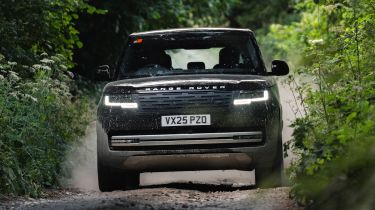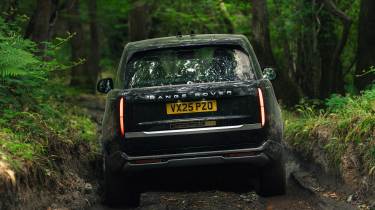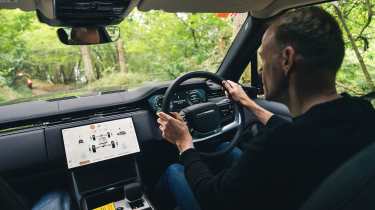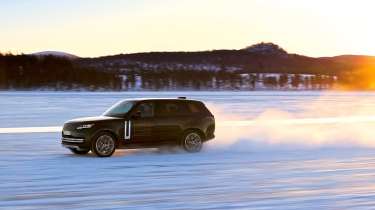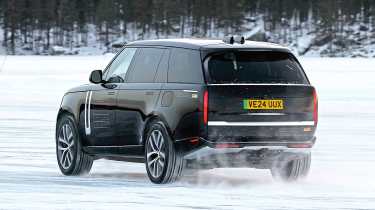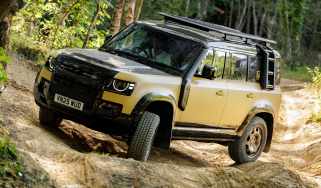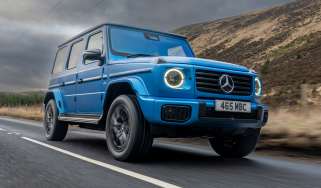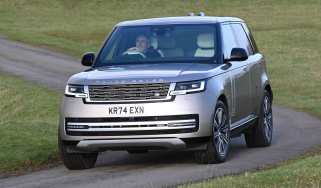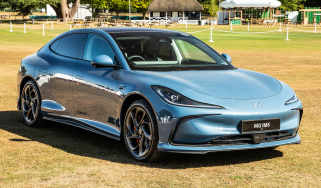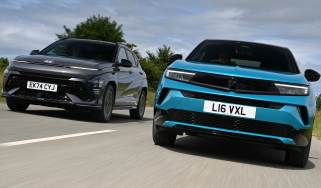New Range Rover Electric 2025 review: luxury SUV could be the ultimate EV
We drive the new luxury Range Rover Electric off-road and on ice
There’s a huge buzz about the Range Rover Electric, even though car fans have known it’s been coming for more than five years and 64,000 people are on the waiting list. That’s because there are no luxury electric SUVs with equal prestige or off-road ability, unless you give Mercedes’ G580 with EQ Technology a pass – which Range Rover’s engineers won’t.
Britain’s flagship e-SUV has two motors (or Electric Drive Units in JLR-speak), one turning each axle and delivering a total of 542bhp and a hefty 850Nm of torque. The Merc has four independent motors, enabling its party trick of spinning on its axis in a ‘tank turn’, but JLR senior off-road specialist Jason Walters dismisses this torque vectoring capability as a gimmick.
“When is tank steer actually usable? It just means you’ve got four big motors burning up energy and you’ve added 4-500kg to the car.” Walters also claims the Merc’s breakover angle is inferior and that the Range Rover’s real-world range – expected to exceed 300 miles – will be superior. It’s all down to JLR’s engineers being pragmatic, and striving to find the sweet spot between weight, battery size, power, efficiency and off-road capability.
Mitigating trade-offs comes up repeatedly during our prototype drive, on Land Rover’s off-road testing tracks surrounding Eastnor Castle, Herefordshire. JLR designed the aluminium architecture to go fully electric from day one, determined to preserve the SUV’s trademark comfort, practicality, cabin and boot space. “First and foremost this is a Range Rover: we’re just offering a new propulsion system,” chief programme engineer Simon Fairbrother tells Auto Express. We reckon it’ll cost around £150,000.
Used - available now

2020 Land Rover
Range Rover
57,700 milesAutomaticDiesel3.0L
Cash £35,500
2020 Land Rover
Range Rover
50,871 milesAutomaticDiesel3.0L
Cash £33,807
2024 Land Rover
Range Rover
21,452 milesAutomaticPetrol3.0L
Cash £77,500
2021 Land Rover
Range Rover
68,000 milesAutomaticDiesel3.0L
Cash £36,950Fairbrother won’t confirm the EV’s precise weight either, but confirms it’s not excessively higher than the short-wheelbase plug-in hybrid’s 2.7 tonnes. The 118kWh, 800-volt battery is housed between the wheels, slightly reducing the breakover angle (the point where the body grounds out as it traverses a peak) to 22 degrees. The upside is the weighty pack lowers the centre of gravity, so the large SUV doesn’t need beefed-up anti-roll bars or complicated chassis control systems to quell roll and pitch. The car still rides on air suspension with dual-adjustable dampers to get a better blend of comfort and handling.
So what has changed? Pull back the gear selector and instead of entering Sport mode, the electric Rangie activates single-pedal driving. The amount of regenerative stopping force varies according to your speed; off road, it’s dialled right down to avoid losing crucial momentum.
Fairbrother claims the electric version has the most patents of any Range Rover, focused on the battery, EDUs and thermal management system. Its heat pump can recover energy at –15C, and the software carefully orchestrates battery temperature to optimise charging. A pre-cooled pack should peak at 350kW on a DC charger, refilling from 10 to 80 per cent in under 30 minutes.
Painstakingly integrating all these systems is one reason why the Range Rover Electric is more than a year late and won’t arrive until 2026. “We’re undertaking the biggest test and development program for a single propulsion system that we’ve [ever done],” concludes Simon Fairbrother. “The car will come to market when we’re ready.”
We drive the Range Rover Electric off road
JLR argues that the Electric feels just like any other Range Rover. The black prototype looks just like one too: the visual changes are restricted to a more streamlined grille and a new rear valance without exhausts; more aerodynamic alloys are coming.
It’s a warm summer’s day, so the 65 miles of tracks around Eastnor are more dusty than muddy. As we climb the gravel paths to the test area, the Range Rover rides as softly as its peers, the body bobbing compliantly as it eases itself over bumps.
Then it’s a sharp, almost 90-degree turn into denser woods. The light steering wheel spins eagerly and the rear-wheel steering pivots the e-Rangie rightwards, with an effortlessness that belies the behemoth’s stature.
The Terrain Response system – which adjusts the drivetrain, brakes, suspension and ride height according to conditions such as sand, boulders or snow – is the same as on any Rangie. Single Pedal Driving maximises control over the springy, responsive accelerator, then Jason Walters selects ‘mud and ruts’ for us to tackle the 20-degree climb known as Gearbox Hill.
Electric’s huge advantage over combustion power is instantly apparent. There’s no need to stop to engage low-range gearing. Electric motors generate mighty torque the instant they spin, and the power delivery is so controllable compared with a combustion engine that has to build revs, and a transmission that may shift into an inappropriate gear.
One squeeze of the throttle and the Range Rover calmly surges upwards. There’s no drama, just intermittent thumping sounds as the brakes grab wheels that have lost traction and begun to slip. We stop the ascent halfway, then smoothly proceed again without scrabbling for traction. This is JLR’s clever Integrated Traction Management software, which responds 100 times quicker than a mechanical system.
We reach the summit. Using the cruise control settings we set the Adaptive Off-Road Cruise Control for 4mph and, like a good rollercoaster, there’s that sense of anticipation as we go over the crest. In conjunction with Hill Descent Control braking individual wheels while maintaining our speed, the Rangie serenely crawls down.
Our brief off-road drive reveals the Electric to be a Range Rover like any other – bar one mighty difference: it’s so blissfully silent you can hear Eastnor’s birdsong. This version of the gas-guzzling-SUV poster child is at one with nature, at last.
We ride in the Range Rover Electric on treacherous Arctic ice
The new Range Rover Electric carries the burden of being the brand’s first electric car, which explains why the engineering team are leaving no stone unturned in the car’s journey to production.
We joined Thomas Müller, Head of Development at Jaguar Land Rover, and chassis guru Matt Becker, who is responsible for the driving dynamics of the entire fleet, in Arjeplog, Sweden, as the cold-weather testing program winds down ahead of another round of testing in the deserts of the Middle East.
Although there are countless electric SUVs on the market, few of them are genuine luxury SUVs. Not many manufacturers have yet electrified a true off-roader, either, so Müller and Becker didn't want to make any compromises.
“First and foremost, this is a real Range Rover and only secondarily an electric car,” says Muller. As we found on the road, this is easy to achieve, because electric drive is perfectly suited to the luxury class, with its effortless power delivery and almost eerie silence.
The heavy battery in the floor also plays into the developers' hands, because it lowers the car’s centre of gravity while increasing its rigidity, ensuring even more sublime composure. In a way that only the Rolls-Royce Spectre can emulate, the Range Rover Electric becomes the ultimate quiet limousine. As a passenger, we feel as though we're nestled in clouds and wrapped in cotton wool, as we're beamed through the Swedish winter landscape on a leather throne.
Off road, on the other hand, an EV powertrain is both a blessing and a curse. Its advantages start with the fact that its power can be regulated much more precisely than with a combustion engine. The downside is that it can be all-too-immediate, not matching the effortless ease with which a petrol Range Rover usually ploughs through mud or snow.
To achieve a more measured delivery, the drivetrain’s computers need to adjust the motors and traction control systems in anticipation of the conditions – something they do with a level of success even in this prototype vehicle.
It pulls away without a single lurch or scrape, even on polished ice or through deep snow and ruts. It can do this with one-pedal driving or the smart off-road cruise control on slippery slopes or climbing steep ramps – even when one side is on asphalt and the other on an icy track.
As if all this weren’t enough to give Müller and Becker considerable headaches, the battery, unlike other parts of the drive system, isn't so adept at climatic extremes. And this despite the fact that the Range Rover, more than most other cars, is actually used just as often in the desert as it is at winter destinations in the Rocky Mountains, the Alps, or even here in Sweden.
To combat this, the team at Land Rover have developed a sophisticated thermal management system that automatically selects the best compromise between interior comfort, charging speed, and range from 700 settings. And the heat pump can deliver energy even at –15C.
The good news is that a BEV powertrain isn’t as complex to package as an ICE engine, meaning there’s no negative effect on other off-roading requirements. Fording depth, approach and ramp angles, and ground clearance are the same as, or better than, the regular car in most driving modes, Müller promises. And given that the existing PHEV models have a kerbweight of almost three tons, the EV’s few extra hundred kilos shouldn’t cause too much alarm for the air suspension.
Visually, there’s almost nothing to distinguish the new EV model from the existing Range Rover. This is because it doesn't use a dedicated electric platform, but rather a compromised hybrid architecture. Yet the company has – credit where credit is due – gone big with the drivetrain.
None of the BMW iX, Mercedes EQS or Audi Q8 e-tron can compete with the dual-motor Range Rover’s 542bhp and 850Nm. That makes the EV the biggest powerhouse in the brand’s line-up this side of the performance SV model.
It runs on a cutting-edge 800-volt electrical system with a 118kWh (usable) battery pack, which should enable a range of "well over 310 miles”. Charging is possible with 22kW AC, as well as that 350 kW DC max. Just like a Porsche, it can bank charge by ‘virtually’ splitting the batteries into two 400V systems, helping it to top up more quickly than much of its main competition.
The only way you can tell that the Range Rover wasn't developed around electric drive is the absence of a frunk, because the space under the bonnet is still packed with hardware. However, one could still be carved in that space – after all, the car won’t go on sale until 2026 – which would make for a nice small storage compartment for the cable.
Yet Müller, Becker, and their team still have much to do, because even if they can hang up their winter jackets, the development program continues. It’s now time to head back into the heat of the desert, because the battery-powered drive still has to prove that it's in no way inferior to combustion engines.
Already, though, the forthcoming electric Range Rover appears confident, silky, quiet and incredibly powerful. The electric powertrain feels like a perfect fit for such a vehicle, where luxury is always more important than pure performance.
And because a Range Rover always has a bit of Defender in it, there are no compromises, even off road. It’ll cost big money, but this is unlikely to bother customers. After all, they're already used to paying high prices for what has always been – and on this account will continue to be – a national icon.
Can't wait for the Range Rover Electric? Configure your perfect regular Range Rover through our Find A Car service now. Alternatively, check out the best deals out there on a new Range Rover from stock or top prices on used Range Rover models...
Leasing deals on the Range Rover EV's rivals

Lotus Eletre

Volvo Ex90

